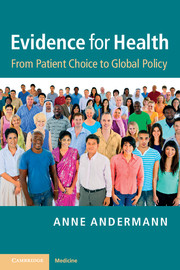Book contents
- Frontmatter
- Contents
- Foreword
- Preface
- Endorsements
- About the author
- Acknowledgments
- 1 Introduction
- 2 Strategies for improving health
- 3 Understanding how decisions influence health
- 4 Producing evidence to inform health decisions
- 5 Facilitators and barriers to using evidence
- 6 Making evidence-informed decisions
- 7 Conclusion
- Index
- References
6 - Making evidence-informed decisions
Published online by Cambridge University Press: 05 February 2013
- Frontmatter
- Contents
- Foreword
- Preface
- Endorsements
- About the author
- Acknowledgments
- 1 Introduction
- 2 Strategies for improving health
- 3 Understanding how decisions influence health
- 4 Producing evidence to inform health decisions
- 5 Facilitators and barriers to using evidence
- 6 Making evidence-informed decisions
- 7 Conclusion
- Index
- References
Summary
Making evidence-informed decisions with the aim of improving health can be facilitated by using a systematic approach. While there is no single way of summarising or ordering the various elements that should be involved in making such decisions, the algorithm shown in Fig. 6.1 lays out many of the key issues that should be considered. Indeed many different types of evidence and value judgements are needed during the decision-making process to answer a wide range of questions, including: (1) What is the priority health problem? (2) What causes this health problem? (3) What are the different strategies or interventions that can be used to address this health problem? (4) Which of these options as compared to the status quo has an added benefit that outweighs the harms? (5) Which options would be acceptable to the individuals or populations involved? (6) What are the costs and opportunity costs? (7) Would these options be feasible in this specific context? (8) What are the ethical, legal and social implications of choosing one option over another? (9) What do different stakeholders stand to gain or lose from each option? And (10) Taking into account the multiple perspectives and considerations involved, which option is most likely to improve health while minimising harms? The remainder of this chapter will go through each of the steps in the algorithm in greater detail.
Define the priority health problem
Whether seeking to improve the health of individuals, populations or our global society, there are generally multiple health problems that could be addressed. Often many of these health problems are inter-related and intertwined. Yet, it is nonetheless helpful to try and identify the priority health problem (or problems) that, if improved, will have the greatest impact on health overall.
- Type
- Chapter
- Information
- Evidence for HealthFrom Patient Choice to Global Policy, pp. 146 - 174Publisher: Cambridge University PressPrint publication year: 2012



